The best woks money can buy
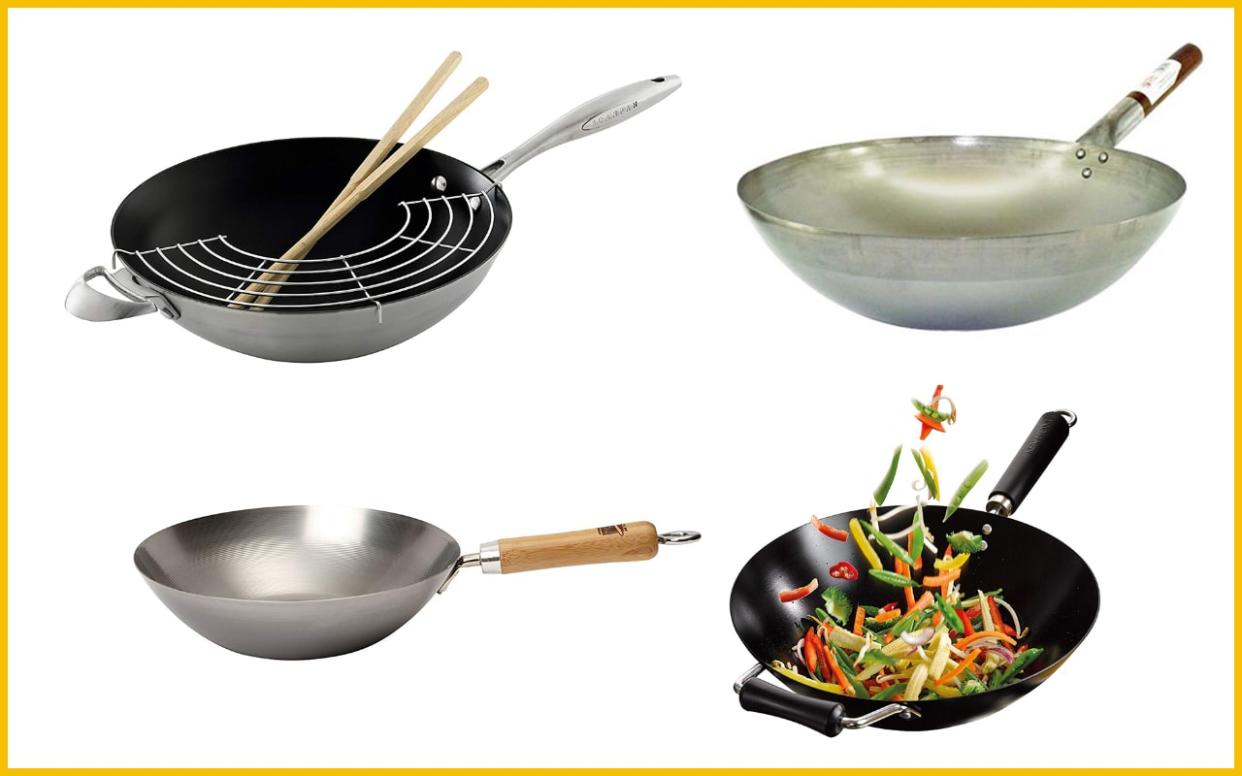
A good wok can transform your stir fry game. It's all down to an effect known as 'wok hei' (meaning 'wok's air' or 'wok's breath'), whereby the pan reaches a fierce heat, and then transfers it in a flash to your sliced and diced ingredients. Buy a good wok and it's 'hei' will ensure you can quickly char the outside of your meat and vegetables while keeping the crunch of a firmer middle. In other words, it will give you that characteristically delicious stir-fry taste.
As someone who counts on this fast, furious method of cooking to whip up the majority of mid-week meals at home, an upgrade on my old pan – which had long lost its non-stick shtick – was long overdue. But what to choose –standard non-stick, non-stick ceramic or traditional carbon steel? Round bottom, or flat bottom?
Non-stick pans will need replacing if the non-stick coating wears off, but they're easier to maintain and wash up. Metal utensils can scratch the coating off, and they're not entirely resistant to high heat: hot fats and oils can also damage the coating (which defeats the object somewhat).
Meanwhile, uncoated carbon steel is preferred by chefs because it generates smokier, tastier dishes, and can last a lifetime if cared for properly. It's renowned for being pretty much indestructible by heat. The only problem? Well, you have to care for it properly – which means seasoning the wok continuously so that it builds up a natural, non-stick patina. (I've explained how to do so at the bottom of this article).
You can use metal utensils with a carbon steel wok, not just wood and silicone, but it must always be thoroughly dried, to prevent rusting.
In terms of metal, other options include cast iron (quite heavy), or even stainless steel, but these are a little more niche, so I stuck to standard non-stick, non-stick ceramic and traditional carbon steel.
Round bottom woks are said to be better at circulating heat evenly to create wok hei, but they don't balance easily on certain types of hob (induction, electric). "Flat bottom woks were invented for flat top hobs, and if the edges are nicely rounded, then you can still get good circulation of heat," says Jeremy Pang, founder of the School of Wok. "However, they're not great if the edges are very angular – things stick to the edges of the base and it acts more like a frying pan than a wok."
With this in mind, in my attempt to determine the very best, I reviewed a selection of woks, judging them for durability, weight, aesthetic, ease of use and maintenance, the feel of the handles when cooking, and depth of flavour (don't scoff: you really can tell the difference on this front).
Here's what I learned, starting with my very favourite, and ending with a beginner's guide to wok wisdom, including cooking tips and advice from the experts.
Hancock 13" round-based carbon steel wok
Why we like it: Authentic, traditional, the best for wok hei, and attractively priced. What's not to like?
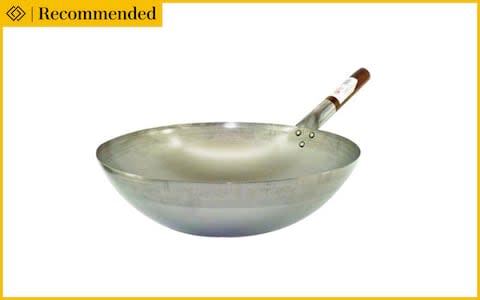
What does your wok say about you? This one says you know how to make a damn good, authentic stir-fry. It's large enough to cook for a crowd (easily serves up to 5-6 people). It's deep rather than shallow, for better heat circulation.
The first thing you have to do when this lands in your kitchen is season it – a process I found intriguing and alarming, having never done it before. The pan undergoes a dramatic colour change, from silver to varying degrees of brown. All in, the process probably took 10 minutes, but after that, it builds up and gets better over time. The more you cook with it, the more flavoursome the layer.
When it came to adding oil for the first time, the wok gave off tremendous amounts of smoke (be warned, you may find yourself manically wafting the fire alarm with a tea towel at this point). And because it's got a round bottom, it see-saws rather precariously on my gas hob (you can buy wok rings and support stands to adapt round bottom woks to flat surfaces).
But the theatre of the process of seasoning is well worth the effort. Cooking with round-based carbon steel is fast, aromatic, fun, and fiery. A simple dinner of stir-fried veg with chilli, ginger and sunflower oil alone was elevated in terms of flavour: lightly blackened and much tastier than in my usual, plasticky non-stick wok, in which the same ingredients are comparatively bland.
According to Ennevor Yap, the director of Wing Yip, the UK's largest oriental supermarket, a seasoned wok allows food to shift and glide easily, preventing your food from sticking. If you're serious about upping your home cooking game when it comes to Chinese-inspired dishes, this is the one for you.
"Due to the high temperature of the carbon steel wok and the build-up of flavours from the seasoning, you’re able to produce that authentic smokey flavour that we all know and love," says Yap.
Because it gets very hot, very fast, Yap's recommends you make sure you have prepped all your ingredients. "As soon as that heat goes on, there will no time for chopping," he says.
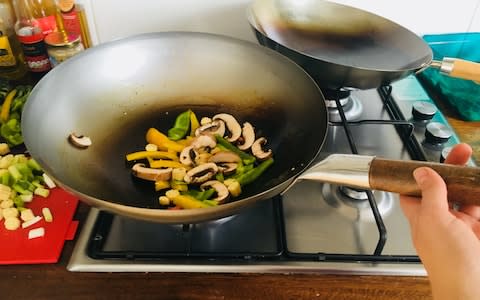
Note that hot wok cooking requires oils with a high smoke point, so think sunflower, peanut or grapeseed, rather than olive oil. One more word of caution: while the chunky wooden handle on this wok remains perfectly cool and easy to grip, the metal itself gets perilously hot.
In terms of keeping it well seasoned, it doesn’t need to be dripping with oil, but just not stripped bare. As long as you don't wash it with soap or scrub it with a metal scourer, you don't have to re-season it. You can use hot water, sponges and traditional bamboo brushes to clean and maintain it, but always make sure you dry it out completely and add another layer of oil with a paper towel afterwards.
Scanpan GTX 12" ceramic non-stick wok
Why we like it: A superior ceramic wok that's perfect for hassle-free cooking and cleaning.
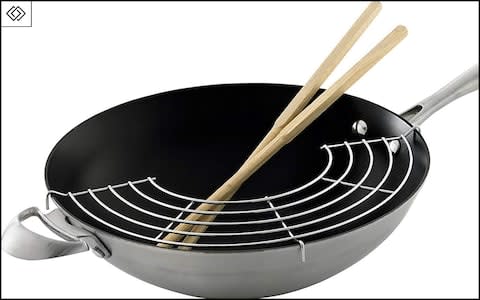
The Scanpan GTX is coated in a non-stick material, so, unlike the Hancock, it can be washed up with a squirt of washing up liquid or bunged in the dishwasher – don't confuse it with lesser, throwaway non-stick woks on the market. This one is an entirely different beast altogether.
"My favourite non-stick pan is the Scanpan GTX – their manufacturing method is unlike anything else on the planet," recommends Jason Moran, owner of Season Cookshop, which offers a careful curation of cookware, painstakingly selected by chefs and home cooks. "It’s got seven layers to conduct heat: they take a molten ceramic and blast it onto the pan at twice the speed of sound."
The multiple layers include alluminium alloy, pure alumninium and stainless steel, all coated in that molten ceramic blast for the non-stick finish. While the resulting intensity of flavour doesn't quite match up to the fiery simplicity of the carbon steel pan, the results are far from bland, delivering deliciousness without the fuss and faff. I also like the fact that it has not just one handle, but two. It's even stocked at Harrods.
According to Moran, non-stick ceramic is the best of both worlds. "It’s low maintenance because of the non-stick coating – food doesn’t get stuck to it, and it doesn’t have to be seasoned – but it can withstand higher temperatures than a Teflon-coated standard non-stick wok."
That said, as with all non-stick woks, it still simply can't take the heat that carbon steel can, so overheating isn't covered by the warranty (hot fat and oil can burn the non-stick coating) which, for me, slightly defeats the object of a method which is all about turning up the heat. "No non-stick pan will last forever," says Moran.
On the plus side, you can use any utensils (including metal) on the patented surface (which is free of the chemical compound PFOA) without fear of damaging it. The cast stainless steel handles stay cool (and look swish). Plus, the whole thing is oven safe up to 260 degrees celcius (handy, if your guests are always late).
It's versatile, too – suitable for induction, solid plate, ceramic, radiant ring, gas or halogen.
A sound buy for easy stir-fries.
Ken Hom performance non-stick 36cm wok
Why we like it: A two-year guarantee makes this the best of the standard non-stick crew.
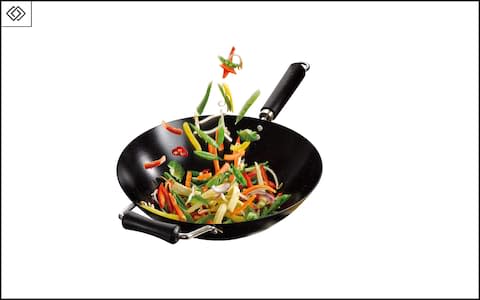
If you really insist on going for a non-stick standard wok, rather than an uncoated carbon steel or a non-stick ceramic wok (my preferences), then Ken Hom's performance non-stick wok is a good bet.
Like the Scanpan GTX, it has an eco-friendly non stick coating (always look out for PFOA-free), and the two-year guarantee promises more durability than other non-stick woks. It's dishwasher safe, and a great size for cooking large portions for family and friends. Like the Scanpan, it has two handles, so it's easy to carry around the kitchen even when it's full of heavy noodles.
However, honestly, I found the richness of flavour pales in comparison to the carbon steel wok, and my stir-fry took longer to cook – but in fairness, the results are evenly cooked and perfectly acceptable.
The best of the rest
Solidtechniks wok
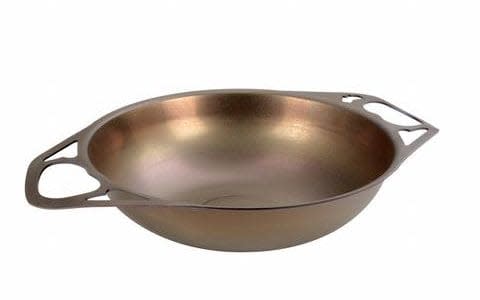
The Solidtechniks wok is worth writing home about, thanks to it's "multi-century" guarantee (it's available from Buy Me Once, the arbiter of sustainable, long-lasting stylish products that promise "a life less throwaway").
It's made in Australia from one seamless piece of fine 2mm Australian iron (low carbon steel). Apparently, that makes it hygienic, because no gunk ends up under the rivet heads. It's a beautiful bronze colour with a gorgeous evolving patina, and it can be heated on any source. The Solidtechniks is lighter than normal carbon steel or cast iron, and I love the fact that it's pre-seasoned with rice bran oil (healthy), so it doesn't require an initial scrub. Also, despite being shallow, it transfers heat beautifully.

My reservation? It has Cantonese-style handles, that you hold on either side. This means that it doesn't put repetitive strain on one arm, and it promises to be better for your back and for preventing fatigue... but to me it just doesn't feel natural. Plus, those handles get too hot for me to comfortably hold on to, and my fingers feel too close to the roaring flame.
School of Wok "Wok Star" 12" carbon steel wok
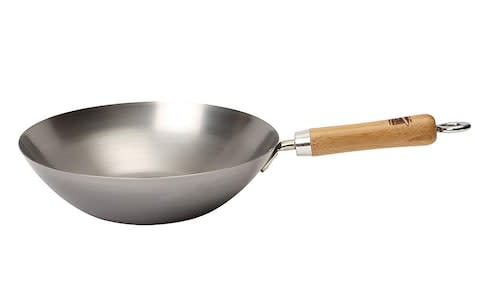
School of Wok is an award-winning Asian & Oriental cookery school located in London's Covent Garden, headed up by chef Jeremy Pang. This 12" carbon steel wok from his range locks in flavour, and is a close contender to the Hancock, though slightly smaller (serves 3-4). It's heavy for its size, which is why I went for the Hancock over this one, but the wooden bamboo handle is pleasant to hold, and it seasons beautifully.

"We designed the bamboo handles with a slight 'groove' or indent in the middle to allow for the perfect 'wok-toss'," explains Pang. I'd definitely recommend it if you're new to cooking with carbon steel, and for the price, it's a brilliant investment – no need to order a takeaway ever again (money saver for me; not such good news for Deliveroo).
GreenPan Cambridge non-stick ceramic wok

The GreenPan Cambridge is another example of an excellent non-stick ceramic wok, a bit like the ScanPan GTX. It's shiny and attractive, and doesn't require too much oil to coat your food; but for me, it was a bit too much like a frying pan in shape, and not enough like a wok.
Salter Pan for Life
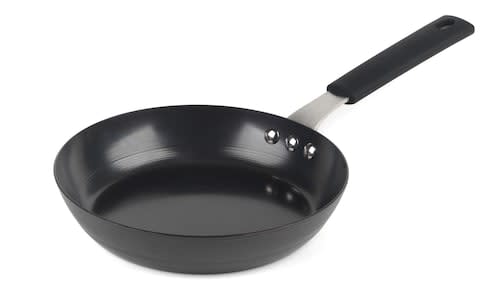
Like the Solidtechniks wok, this wok from Salter is pre-seasoned, which removes the chore of seasoning a new wok. All that's left to do is get cooking and building up layers of flavour on the black carbon steel. Another great option for those not used to cooking with carbon steel, and who fancy the idea of building up a flavoursome layer to enhance their cooking.
It comes with a lifetime guarantee, it's oven safe up to 200°C, and is both PFOA and PTFE free. The rubber handle is excellent in terms of grip, but it's not a huge pan, so I'd recommend it for couples or small families.
Wok FAQ
Ready to turn up the heat? The School of Wok’s Jeremy Pang shares his top tips to demystify the process. Check Pang's book Chinese Unchopped for more tips and recipes, including Sichuan chicken, Singapore noodles and flash-fried cabbage with dried chillies and sweetened soy.
What can woks be used for?
All types of cooking, but mainly: stir-frying, steaming, deep frying, braising (if thicker based), poaching and blanching, and boiling... just not for roasting!
What are the different types? What kinds of wok are best and why?
Woks can differ in shape, size, thickness, and type of material: The size of your wok (diameter) will dictate how many people it may serve. The first ever woks that were made were actually ceramic, however over time, clay moulds were used to shape cast iron into woks, which decreased cooking time significantly as cast iron conducts heat much better.
Cast iron woks are much heavier and so more difficult to 'wok' with, and so the modern day wok is often made of carbon steel (also a great conductor of heat, but much lighter in weight).
Thin woks tend to be used much more for quicker cooking methods such as stir-frying, blanching and boiling. If you are keen to deep fry, braise or poach in a wok, this can be done in any type of wok, however the thicker based cast iron woks may be more useful in this case.
There is no reason why you can't cook most things in a wok, but there are of course better woks for certain types of cooking. For example, if you want to cook your bolognese in a wok, then perhaps a thicker based wok is better to do so.
How do you season a carbon steel wok?
A wok will only get better over time, so long as you look after it properly. To season your wok properly, follow these steps:
If it has one, scrub the anti-rust layer well off the wok using a metal scourer and clean well
Heat on a high heat and burn your wok for the first time... The wok should go through a whole load of colour changes before going a slightly blue-grey in colour. Try to burn your wok all the way around (if you are on electric/induction/halogen hobs, use a blow torch for best results)
Allow wok to cool for a few minutes
Now rub some vegetable or sunflower oil onto the inside of the wok using a piece of kitchen towel
Burn your wok again... This time, your wok will smoke up. Allow the wok to smoke and change colour once again. Once the wok has stopped smoking and the colour has changed to a matt dark grey, it has been seasoned and should be ready to use
Make sure to season all the way around the wok, not just on one spot
What’s your favourite kind of wok?
The best type of wok for me would be a round bottom, uncoated, carbon steel wok, which allows for a great continuous circulation of heat, allowing you push the 'woks air' around the wok evenly. Personally, I would never use a wok smaller than 12” as I'm constantly cooking for larger groups of people! The smaller woks are great for individuals and couples. But even then, my usual go to is a 13” round bottom wok.
Is it a good idea to get accessories like lids, wok rings and bamboo steamers?
Always. I'll start with a bamboo steamer (10" bamboo steamer, £20, Amazon): the bamboo weaving is fantastic for steaming as it collects condensation (as opposed to metal or glass lids that lend themselves to a lot of dripping water). When steaming delicate things like dumplings, bread or even fish, no excess water drips onto the ingredients.
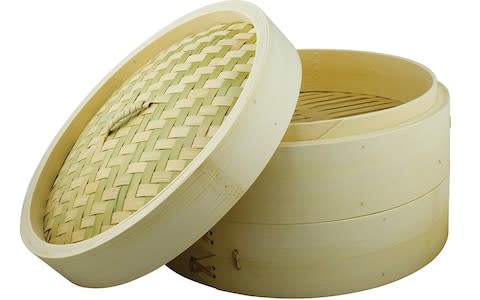
Wok rings (see stainless steel School of Wok 10" wok ring, £6.53, Amazon) are great for using round bottom woks on flat surfaces. Tall, domed wok lids (such as the Dexam aluminium wok lid 32cm, £6.50, Amazon) are fantastic for a 'quick steam' or speeding up cooking processes, or if you wish to steam a whole fish that is bigger than your bamboo steamer.
Top tips for cooking with a wok?
Keep it on a high heat, and never lose your sizzle. Use high-heating oils to cook with (not olive oil or sesame oil). To cool your wok down, there are four techniques I use – stir (it's a stir-fry, after all), fold, wok toss (long push forward, quick flick back), and “the tummy and the head” – round and round with a utensil, and simultaneously back and forth with the wok.


 Yahoo News
Yahoo News 